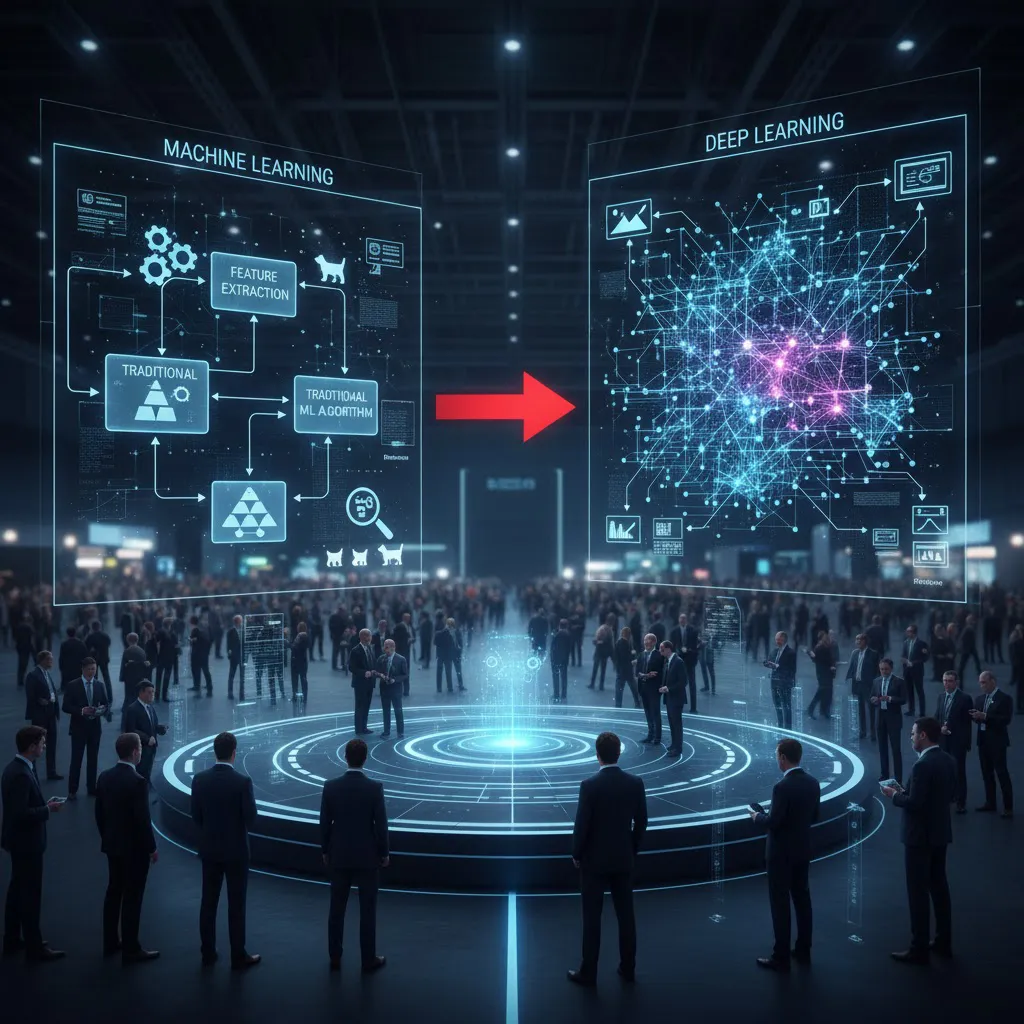Machine Learning vs Deep Learning: Understanding the Core Differences
In the ever-evolving world of Artificial Intelligence (AI), two terms are often at the center of discussion - Machine Learning (ML) and Deep Learning (DL). These technologies are transforming industries, powering intelligent systems, and redefining how we interact with technology. Yet, despite their widespread use, many people are still unsure how they differ or where they overlap.

This comprehensive guide explains Machine Learning vs Deep Learning, exploring their foundations, applications, strengths, and challenges. By the end, you’ll have a clear understanding of how these technologies shape our modern world - and where the future is heading.
1. What Is Machine Learning?
Machine Learning (ML) is a branch of Artificial Intelligence that enables computers to learn from data and improve over time without being explicitly programmed. Instead of following fixed rules, ML systems analyze large amounts of data, identify patterns, and make predictions or decisions based on what they’ve learned.
In simple terms, Machine Learning teaches a computer how to learn from examples. For instance, an ML model can be trained on thousands of labeled cat and dog images. Over time, it learns to distinguish between cats and dogs based on pixel patterns, edges, or shapes - even without human guidance.
ML algorithms can be divided into three main categories:
- Supervised Learning: Models learn from labeled data to predict outcomes.
- Unsupervised Learning: Models analyze unlabeled data to uncover hidden patterns.
- Reinforcement Learning: Systems learn by trial and error to maximize rewards.
2. What Is Deep Learning?
Deep Learning (DL) is a specialized subset of Machine Learning inspired by how the human brain works. It uses Artificial Neural Networks (ANNs) - systems of interconnected nodes (or “neurons”) - that can automatically learn complex representations from massive datasets.
Unlike traditional ML, Deep Learning doesn’t rely heavily on human feature selection. Instead, it processes raw data (like images, audio, or text) through multiple layers to extract high-level features and patterns. This is what makes deep learning so powerful in fields like computer vision, speech recognition, and natural language processing.
In practice, DL has been the driving force behind innovations like autonomous vehicles, voice assistants, and facial recognition systems.
3. The Relationship Between Machine Learning and Deep Learning
The relationship between Machine Learning vs Deep Learning can be visualized as a hierarchy. Deep Learning is essentially a part of Machine Learning, which itself is a core component of Artificial Intelligence.
AI → Machine Learning → Deep Learning
This means all deep learning is machine learning, but not all machine learning is deep learning. The main distinction lies in how they process data and the complexity of their models.
- ML relies on structured data and manual feature extraction.
- DL handles unstructured data (like videos or text) and learns features automatically.
4. Key Differences Between Machine Learning and Deep Learning
Let’s look deeper into the main differences between Machine Learning and Deep Learning:
1. Data Requirements:
- ML works well with smaller datasets.
- DL needs vast amounts of data to perform accurately.
2. Hardware Dependency:
- ML can run on regular computers.
- DL requires powerful GPUs or TPUs due to complex computations.
3. Training Time:
- ML algorithms train quickly.
- DL networks take much longer because of their deep architecture.
4. Human Involvement:
- ML requires manual feature selection.
- DL automatically extracts and learns features from raw data.
5. Accuracy:
- ML is accurate for simple tasks.
- DL outperforms ML on complex, high-dimensional data.
5. How Machine Learning Works
The process of Machine Learning involves several key steps:
- Data Collection: Gather high-quality, relevant data.
- Data Preprocessing: Clean, normalize, and split data into training and testing sets.
- Model Selection: Choose an algorithm - such as Linear Regression, Decision Trees, or Support Vector Machines.
- Training: Feed the training data into the model to identify patterns.
- Evaluation: Test the model with unseen data to measure accuracy.
- Deployment: Apply the trained model to real-world tasks.
Machine learning models improve continuously as they are exposed to more data, making them highly adaptive.
6. How Deep Learning Works
Deep Learning takes inspiration from the human brain. Each layer of a neural network processes data and passes its output to the next layer. The first layers detect simple features (edges, colors), while deeper layers detect complex ones (faces, objects, meanings).
Key components of Deep Learning models:
- Neurons: Basic units that process and transmit signals.
- Weights and Biases: Adjusted during training to minimize prediction errors.
- Activation Functions: Help the model learn non-linear relationships.
Popular deep learning architectures include:
- Convolutional Neural Networks (CNNs) for image recognition.
- Recurrent Neural Networks (RNNs) for sequence-based tasks like speech.
- Transformers for language models like ChatGPT and BERT.
7. Applications of Machine Learning
Machine Learning powers many technologies we use daily. Common examples include:
- Email filtering: Detecting spam or phishing messages.
- Recommendation systems: Suggesting movies on Netflix or products on Amazon.
- Predictive analytics: Anticipating customer behavior or market trends.
- Finance: Detecting fraud and automating trading.
Machine learning also plays a major role in healthcare, agriculture, and logistics - optimizing processes and enabling data-driven decisions.
8. Applications of Deep Learning
Deep Learning is the engine behind most modern AI breakthroughs. It thrives in environments with vast, unstructured data. Examples include:
- Image recognition: Identifying objects or people in photos.
- Speech recognition: Converting spoken words into text.
- Natural Language Processing (NLP): Powering chatbots, translators, and virtual assistants.
- Autonomous driving: Interpreting sensor data to navigate safely.
Deep learning’s ability to handle complexity and learn hierarchically makes it invaluable for futuristic technologies.
9. Pros and Cons of Machine Learning vs Deep Learning
Machine Learning Advantages:
- Works well with smaller datasets.
- Requires less computing power.
- Easier to interpret and debug.
Machine Learning Disadvantages:
- Limited with complex or unstructured data.
- Requires manual feature engineering.
Deep Learning Advantages:
- Handles complex, high-dimensional data effectively.
- Learns features automatically.
- Exceptional accuracy for visual and language tasks.
Deep Learning Disadvantages:
- Needs large datasets and high-performance hardware.
- Difficult to interpret (“black box” problem).
10. The Future of Machine Learning and Deep Learning
The future of Machine Learning vs Deep Learning looks promising, as both continue to evolve rapidly. Emerging trends include:
- AutoML (Automated Machine Learning): Making ML accessible without deep technical expertise.
- Edge AI: Running deep learning models on small devices for faster, private processing.
- Explainable AI (XAI): Improving the transparency of deep learning systems.
- Hybrid AI: Combining symbolic reasoning with deep learning for human-like intelligence.
As data grows exponentially, both ML and DL will continue to power innovation - from smarter cities to personalized healthcare.
Conclusion
In summary, Machine Learning and Deep Learning are not competing technologies but complementary ones. Machine Learning provides the foundation for teaching computers to learn from data, while Deep Learning takes that learning to new depths using neural networks.
Understanding their differences helps businesses, developers, and researchers choose the right approach for their goals. Whether it’s predicting sales trends or enabling self-driving cars, the future of AI depends on the powerful synergy between Machine Learning and Deep Learning.











